Menu
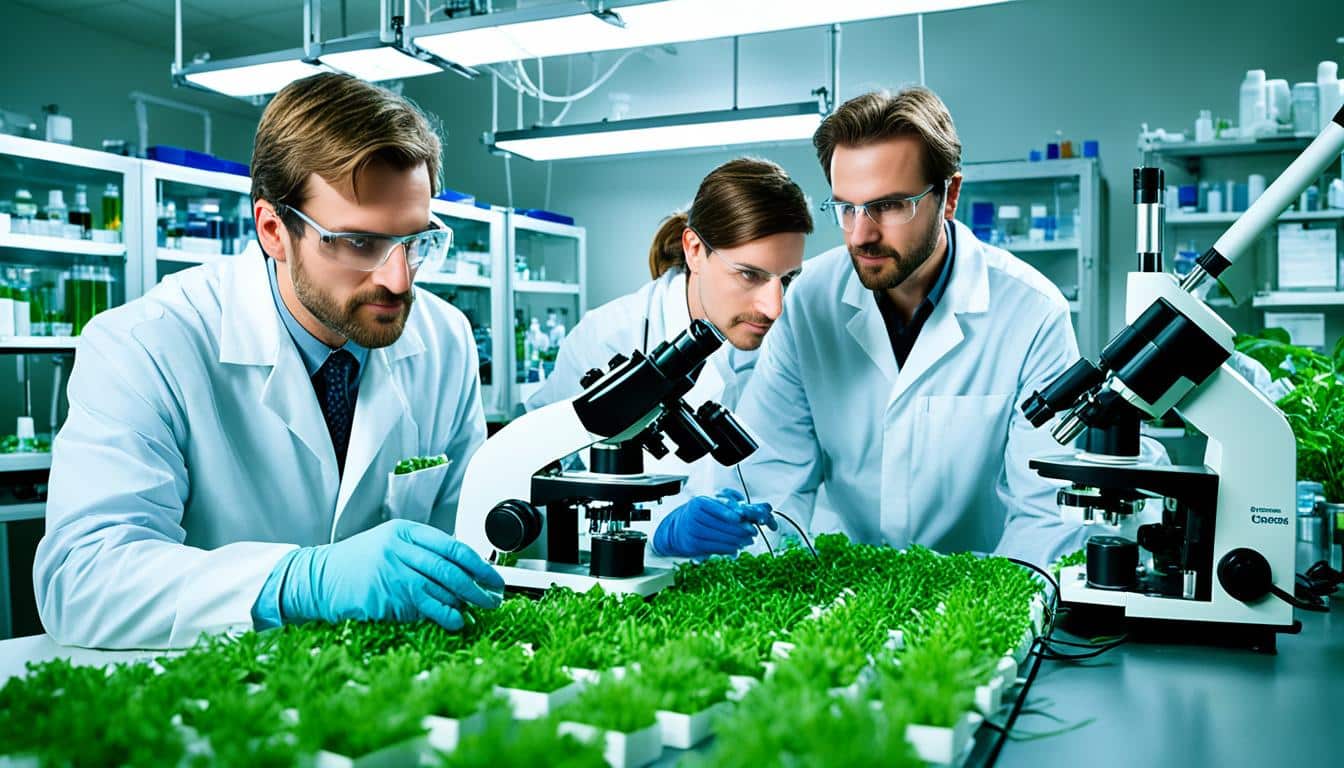
In 2012, the United States used biotechnology for 88% of corn, 94% of cotton, and 93% of soybeans. This was a significant shift in farming practices. It shows how quickly modern technology has been adopted in farming.
Agricultural biotech research brings new ways to make crops better and more sustainable. For example, CRISPR-Cas9 allows scientists to make very precise changes to genes. This can make plants better at fighting off pests and not needing as many pesticides.
Also, it can add important nutrients to food, making it healthier for everyone. By making these changes, we can grow food in ways that are better for the earth too. This is important for our future and the health of our planet.
Biotech research also helps us learn about plants and animals more than ever. As we learn more, we can find ways to use our resources wisely. This is essential to make sure everyone has enough food to eat while not harming our planet’s health.
Agricultural biotechnology uses many tools to improve plants and animals for farming. It focuses on helping them survive better in tough environments. The progress in this field shows that biotechnology is crucial for farming.
Biotechnology in agriculture means using special scientific methods to make plants, animals, and tiny organisms better. For example, it’s helped make cotton that bugs don’t eat, soybeans that aren’t harmed by weed-killing chemicals, and papayas that can fight off a dangerous virus. These changes make crops better, help farmers grow more, and make farming easier and more profitable.
Biotech is very important in agriculture today. In the USA, in 2012, most crops like corn, cotton, and soybeans were created using biotechnology. This has meant using fewer dangerous chemicals and protecting important farm industries. By using biotech in farming, we can tackle big issues like making sure there’s enough food, farming in a way that doesn’t harm the environment, and getting rid of pests safely.
| Biotech Crop | Percentage Planting in 2012 | Environmental Benefit |
|---|---|---|
| Corn | 88% | Reduced pesticide use |
| Cotton | 94% | Non-toxic herbicides |
| Soybeans | 93% | Enhanced soil health |
New crop technology advancements are all about making crops better at handling tough conditions like salty soil or drought. This helps deal with problems linked to climate change. In 2012, a lot of the world’s farmers were already using biotech crops. Looking ahead, biotechnology will keep helping farmers be more successful and look after the planet.
Precision breeding changes the game in farming. It allows us to tweak plant DNA very precisely. This helps deal with big farm issues and creates new ways to grow food sustainably.
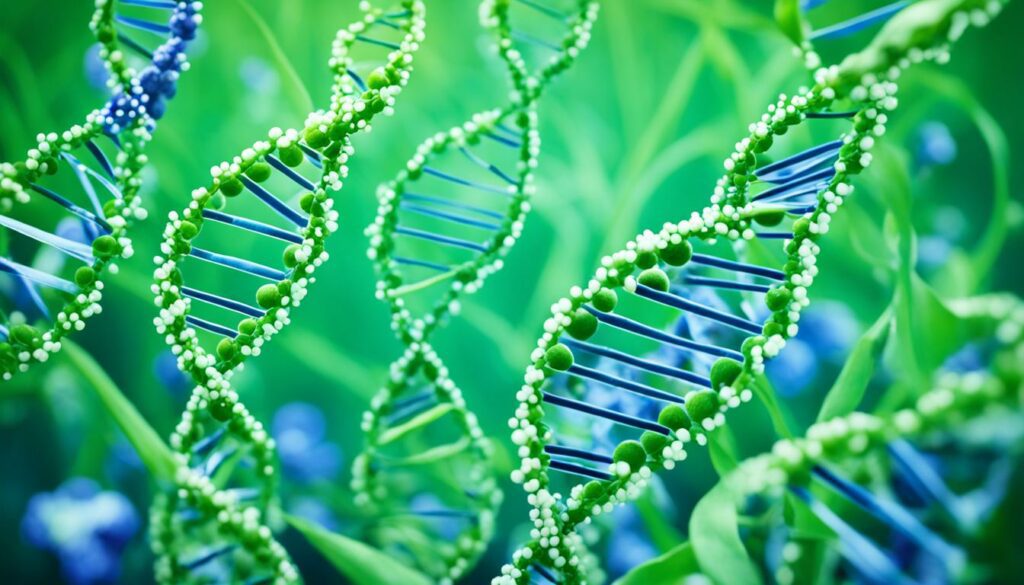
Precision breeding is like using a fine tool on genes. It doesn’t mix up all the genes like before. Instead, it adds or modifies specific genes to get the traits we want. This lets us quickly make crops stronger and better at dealing with tough conditions.
Important in precision breeding is using enzymes to cut DNA into smaller parts. This makes it easier to work with and change the genes we need. Plasmids help by making more copies of these genes in bacteria. With this approach, we can add new traits to plants without waiting for lots of breeding.
Precision breeding is much faster and more accurate than old ways. By focusing on specific genes, it can create plants that are better at surviving pests, droughts, or that are more nutritious.
It’s also key for making farming sustainable. As we have less land and face challenges like less water and climate change, precision breeding offers a way out. England and other countries have made laws to support these advanced crops. This makes it easier to use them and move farming forward.
A big plus of precision breeding is how exact and effective it is. We can remove harmful traits from plants or turn off genes that cause issues. This helps in making plants healthier and more productive.
In the end, precision breeding is a game-changer for agriculture. It’s a high-tech path to better crops, more sustainable farming, and dealing with hunger worldwide.
For thousands of years, humans have been improving plants through selective breeding. The journey has been long, from the wild grass called teosinte to today’s maize fields. But now, with CRISPR-Cas9, we’ve opened a new chapter. This technology lets scientists edit plant DNA very precisely. They can change the genes that control things like disease-fighting abilities and how much food the plants produce.
CRISPR-Cas9 is much more exact than older methods. With conventional ways, like using radiation, the changes made to plants were random. But CRISPR-Cas9 can go straight to the genes that need changing. This greatly lowers the chance of getting unwanted side effects. In rice, for example, scientists have used it to improve the plant’s ability to withstand high temperatures and salty soil.
Using CRISPR to edit plant genes is also simpler than adding foreign DNA, which is the case with some older techniques. This simplicity means less red tape to get through. Since no new genes are being added, the method is also more widely accepted around the world.
In 2020, the creators of CRISPR won the Nobel Prize in Chemistry. This highlighted how important the technology is in the world of gene editing. Now, more and more people are applying for patents related to CRISPR in agriculture. The US, Australia, and Canada are ahead in this, with Europe also being very active in this area.
While China is ahead in publishing gene editing studies, it hasn’t put down clear rules for using this technology on plants or food. This is different from the US and Europe, where laws are clearer. Still, since many CRISPR-Cas9 patents come from these places, we know there’s a lot of work being done there.
“CRISPR tools now enable changes to plant DNA without introducing foreign genes, making the process quicker and less regulated,” I noted. This advancement is playing a pivotal role in deepening our understanding of plant biology and creating robust crops that require fewer resources.
CRISPR-Cas9 and other gene editing techniques are moving agricultural science forward. They show great promise in helping us feed the world, especially as the climate changes and the population grows.
Biofortification is key in fighting vitamin and mineral shortages through food. It improves staple crops by adding essential nutrients. This change is making the world healthier.
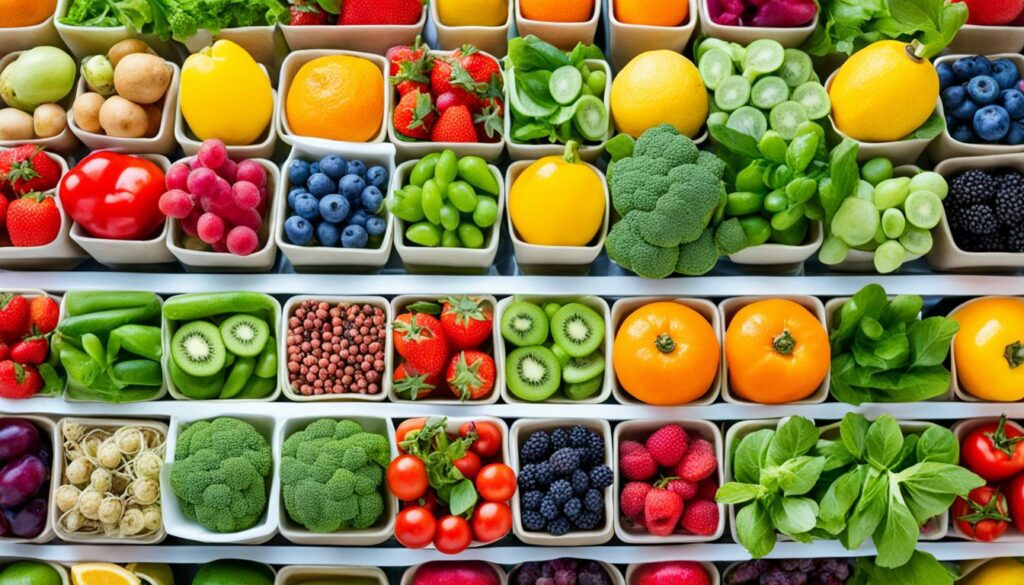
Biofortification uses various genetic tweaks to add nutrients. For instance, beans, cowpea, and pearl millet have more iron. Maize, rice, and wheat are richer in zinc. Key crops like cassava, maize, and sweet potato have more pro-vitamin A too. This helps people get nutrients they often lack.
In Mozambique, Uganda, and South Africa, orange sweet potatoes cut vitamin A deficiency. In rural Uganda, foods with β-carotene made a big difference. This approach is a big win in fighting global nutrition problems.
Biofortified crops significantly help public health. They boost iron levels in women in the Philippines and kids in India. Rwanda also saw better iron levels in women, leading to big health improvements.
People accept these enhanced crops well. For example, even if the colour changes, as seen in crops with more vitamin A.
Creating a market for these crops is vital. Research shows the need for nutrient-rich, high-yielding crops. Biofortification makes food more nutritious without needing extra supplements. This can help fight malnutrition worldwide, economically.
From November 8 to 10, 2023, a webinar series on Biotech Innovations for Sustainable Agriculture took place. It focused on introducing key advancements in agricultural biotech. This was to help the industry towards more sustainable practices and protect the ecosystem.
One standout talk was by Dr. Reynante L. Ordonio about plant breeding. He talked about genome editing’s power, especially in creating plants that can survive droughts and need less nitrogen. These crops solve big issues in farming.
Dr. Gabriel O. Romero discussed how biotech crops lower the need for pesticides. This is important for sustainable farming, as less pesticide means a healthier ecosystem.
Ms. Geronima P. Eusebio went over the Philippine’s regulations on plant breeding. She mentioned a key circular, DA Memorandum Circular No. 08, s2022. These rules are critical for the safe use of biotech in agriculture.
Dr. Marvin A. Villanueva and Dr. Claro N. Mingala talked about the need for clear policies on GM animals. Such policies are essential for moving forward in animal biotechnology while staying safe.
Dr. Casiano H. Choresca Jr. explored biotech’s role in aquaculture. He highlighted tools for sustainable seafood. Biotechnology helps farming on land and sea to keep going.
Here is a detailed table on the insights from the webinar:
| Speaker | Contribution | Key Point |
|---|---|---|
| Dr. Reynante L. Ordonio | Plant Breeding Innovations | Efficiency of Genome Editing |
| Dr. Gabriel O. Romero | Biotech Crops | Reduction in Pesticide Use |
| Ms. Geronima P. Eusebio | Regulatory Status | DA Memorandum Circular No. 08, s2022 |
| Dr. Marvin A. Villanueva | GM Animals | Adaptive Policies |
| Dr. Casiano H. Choresca Jr. | Biotechnology in Aquaculture | Sustainable Seafood Production |
To truly have sustainable agriculture, we must balance caring for the environment, making money, and acting responsibly to society. Biotechnology helps us achieve this. It boosts farming’s productivity and quality while keeping our ecosystems healthy for those who come after us.
Modern farming has evolved with the integration of advanced technology. This has given birth to smart farming. Smart farming combines the latest developments like the Internet of Things, precision agriculture, and automated analysis. It improves how we farm, making it more efficient and based on solid data.
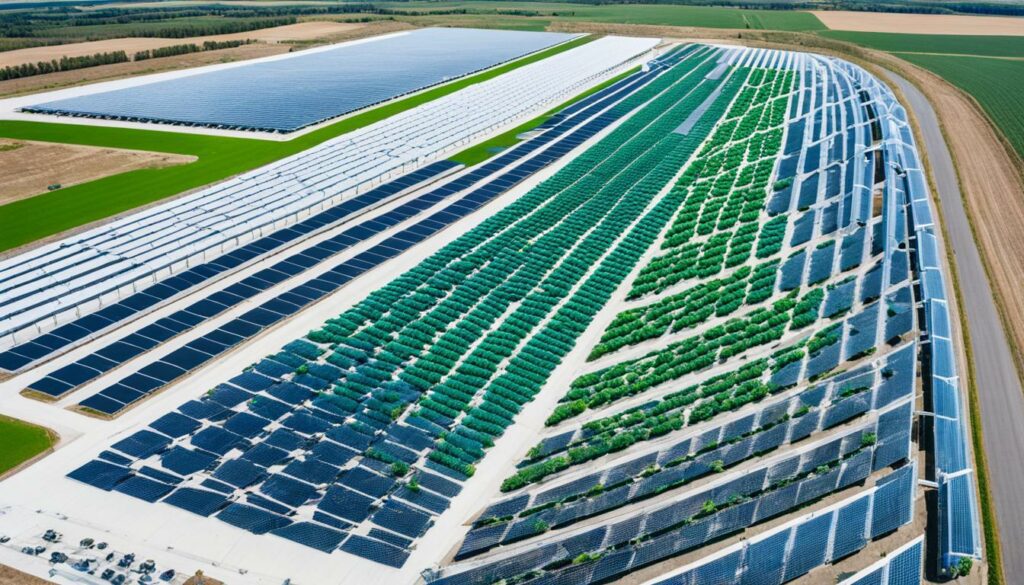
Using IoT in farming is changing how we look at the fields. Now, with sensors and data tools, farmers stay up-to-date on the status of the soil, water, and weather. This tech allows for precision farming, making smart decisions on when to plant, water, and fertilise.
Digital agriculture brings together knowledge from engineering, IT, agronomy, and biotechnology. It offers a complete way to manage a farm. This approach helps grow stronger plants that produce more food. It boosts our food security.
The Indian Council of Medical Research highlights the need for enough nutrition, made possible through better farming. IoT lets farmers use methods that are efficient and help save resources. This meets the challenge of making farming sustainable to feed the world.
Moreover, digital tools like drones and live monitoring catch problems early. This leads to better crops and promotes farming that’s friendly to the environment. It saves resources and keeps the balance in nature.
At its core, smart farming is more than just using new tech. It’s a shift to farming that’s precise, data-focused, and kind to the planet. As farming tech and biotech join forces, a future of farming that’s both sustainable and highly productive emerges.
Aquaponics and hydroponics are modern farming methods. They mix the latest farming techniques with eco-friendly ways. This leads to efficient and earth-friendly systems.
The aquaponics system is a smart combo of fish farming and growing plants without soil. It lets fish waste feed the plants, showing off a circular process. This way, it uses fewer resources and creates almost no waste. A top example of this is The GrowHaus in Denver. It not only grows food for locals but also teaches ways to do it. The approach could be a big help in the future as it doesn’t need much space.
Hydroponics has improved a lot over time, moving from ancient wonders like the Hanging Gardens. It started in the 19th century and grew with new ideas like aeroponics in the 20th century. By not using soil, it saves water and land, yielding more crops. Gotham Greens in New York City and AeroFarms in New Jersey are great examples. Yet, there are still puzzles to solve like keeping plants safe from diseases. But, progress is steady, making hydroponics even more efficient and earth-friendly.
Vertical farming is a groundbreaking change in urban agriculture. It lets us grow crops in stacked layers, saving space. This method became real in 2011, thanks to Dickson Despommier’s idea. It changed how we think about growing a lot of food in small areas.
Vertical farming uses much fewer resources than traditional ways. It needs less water, land, and pesticides. Big names like AeroFarms are working hard with schools and experts to make crops better and yield more.
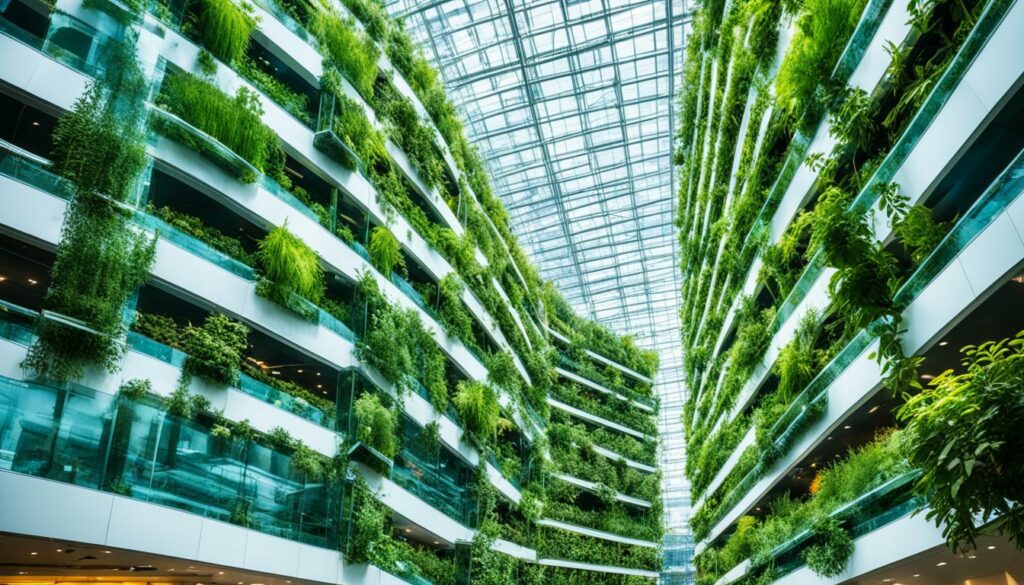
Now, vertical farming includes advanced tech like robots and AI. These techs make energy-efficient systems for growing different crops. This makes the best use of space and helps feed more people, fighting food security and urban challenges.
The idea of vertical farming goes back to the early 1900s but grew a lot in the 1990s. Projects like the Vertical Farm Project and Sky Greens in Singapore show it’s catching on globally. Places like Green Sense Farms prove we can grow lots of food in a small space.
Today, we use smart LED lights and automation to farm vertically even better. These help tackle problems like not enough sunlight and needing strong structures. The future of vertical farming looks bright. It can make a big difference in how we grow food in cities and in sustainable ways.
“Vertical farming holds the promise of addressing the pressing issue of food security in densely populated urban areas while promoting sustainability.”
In the end, vertical farming shows off human’s smart use of space and sustainable farming in cities. It’s a good way to feed more people as the world’s population grows.
Robotics in farming is changing the game, making it more precise and reliable. Technologies like self-driving tractors and drones are becoming common. They make work easier, safer, and they help grow better food.
Recently, Novo Nordisk funded a big project at the University of Copenhagen, giving DKK 60 million (€8.05M). This project aims to improve crop health and reduce the use of harmful chemicals.
Global demand for food is rising fast. By 2050, we’ll need 60% more food. So, technology like robotics is extremely important for the future of farming.
Europe wants to cut pesticide use by half by 2030, but there are worries. So, a big project involving 100 farms is underway in Denmark and England. This includes 11 Ph.D. students working on new robotic farming solutions.
Agriculture is very important for many countries’ economies. It can make up to 18% of a country’s GDP. With growing global population and food needs, we must find new ways to farm.
Automation has been changing farming for a while now. It’s shifting from human work to machines, powered by energy and AI. The use of robots in farming started in the 1950s. There have been many advances since then.
The market for farming robots is set to more than triple by 2028. North America leads the way in using these new technologies. Dairy farms, for example, are increasingly using robots to manage their animals.
FarmWise is at the top of the game, raising $73.9 million in funding. This shows how much faith investors have in the future of farming technology.
Biopesticides are a green replacement for chemical pesticides. They fight pests without hurting other animals.
Biopesticides come in three forms: microbial, plant-incorporated, and biochemical. Microbial ones use tiny life forms like bacteria to kill pests. Bacillus thuringiensis (Bt) leads, covering 90% of these.
Plant-incorporated biopesticides tweak plants to fight off bugs. Biochemicals are natural substances that stop pests.
Biopesticides are part of a global push towards more eco-friendly farming. They’re precise, meaning they kill the right pests without widespread harm. This reduces the need for harsh chemicals.
Old methods like spraying leaves have their downsides. New tech, like what Phoreus Biotech makes, is changing this. Technologies like BAPC and CAPC make biopesticides stay effective for longer. They’re safer for the environment and help save useful bugs too.
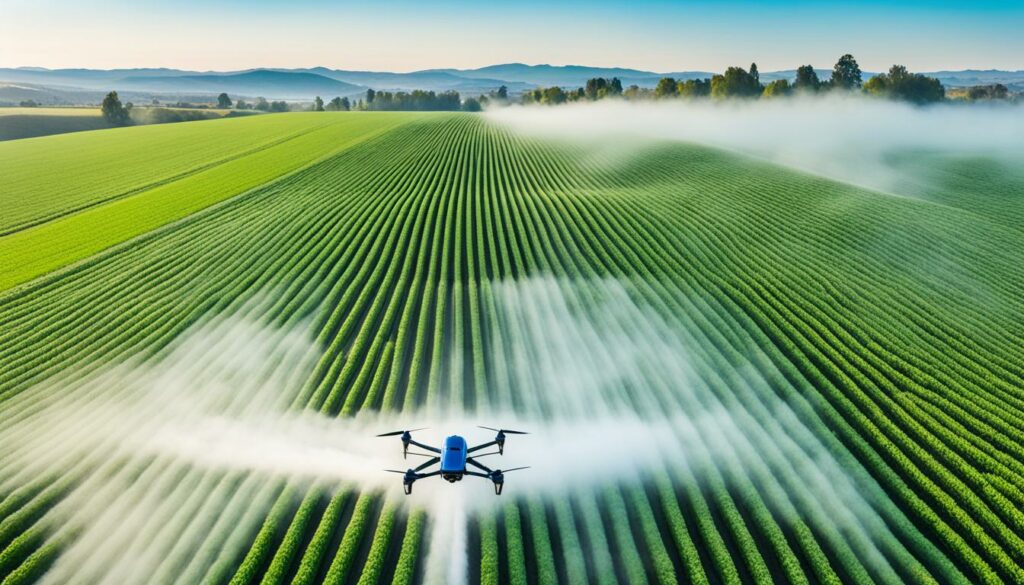
Biopesticides that use RNAi can switch off pest genes. They are seeing more use each year, while synthetic pesticides are falling out of favour. The farming industry is keen on using biopesticides more. Reports show they are a big step in making farming less harmful to the planet.
Genetic engineering has changed farming significantly. It has made crops better in yield, nutrition, and fighting off problems. These changes are seen in the high use of biotech crops, like corn and soybeans, in the US. In 2012, most of these crops were genetically improved, showing how important genetic engineering is for farming.
Insect-resistant cotton is a standout example. It means fewer harmful pesticides are needed. This is good news for the planet. Adding to that, making crops that can handle herbicides has helped control weeds better. This allows farmers to use less soil and still grow plenty of food.
On another front, genetic work has made our food safer. Scientists now know more about how living things work, making food better and farming easier. Plus, there’s the exciting use of genetic engineering to create vaccines for animals and to produce antibiotics in a more eco-friendly way. This shows the wide range of benefits from biotechnology in farming.
Groups like the USDA, EPA, and FDA make sure biotech crops are safe before they reach us. This process makes people trust the new methods being used in farming.
But it’s not just about crops. Genetic work has also made vaccines for animals and produced antibiotics. These show the many useful ways we can use genetic engineering in farming.
| Crop Type | % Biotechnology Plantings in 2012 |
|---|---|
| Corn | 88% |
| Cotton | 94% |
| Soybean | 93% |
Farming is looking towards the future. Genetic engineering will play a big role in making sure we have enough food and do it in a way that’s good for the earth. It’s clear that biotechnology is key for the future of farming.
Agri-genomics is all about plant genes. Scientists study them to learn how they work. This helps in making plants better at fighting off pests, diseases, and surviving climate changes.

Plant genome sequencing is important because it spots differences in genes. These differences can be linked to good plant qualities. This helps make new plant types that grow better and survive more, meeting the world’s need for more food and tough plants.
New genetic sequencing tools like NGS and bioinformatics are changing the game. They find differences in genes and connect them to how plants grow or look. Thanks to technologies like Illumina, we’re seeing quick progress in decoding plant DNA. This progress is giving us new ways to tweak plant genes for better crops like rice, wheat, and soybeans.
Agricultural biotech has changed farming forever. Since 1987, it has given us quick and efficient ways to grow food. With these methods, we’ve seen crops that can resist more herbicides. We also have safer vaccines against diseases caused by viruses and bacteria.
Compared to traditional ways, using biology is faster and more precise. This new technique can put specific genes into plants, changing their traits. But to make the most of this, we need talented people and a lot of money.
We use special tools for changing genes, like restriction enzymes. They help make the process smoother. Then, there are the vectors like the Ti plasmid and the P-element. These are key for moving the genes into the right place in the plant or animal.
All this technology allows us to make better crops and animals. With more research, it’s also making food and our health safer. But, it’s important to be careful and follow strict rules when using biotechnology.
Working together, countries and scientists can solve the big problems biotech brings. Slowly, we’re getting closer to making sure everyone has enough food. It’s an exciting time for farming. A time where we can make sure food, the earth, and our future are safe together.
Agricultural biotechnology uses many tools, such as genetic engineering. These tools change organisms to make them better in farming. This includes everything from old breeding methods to new ones like CRISPR-Cas9 for fixing genes.
Agricultural biotech research is key. It makes crops and animals stronger against tough conditions. This means more food for everyone in a way that’s kinder to the Earth.
Precision breeding changes genes to improve crops quickly. It speeds up the process compared to older breeding ways. As a result, crops can grow more, fight diseases better, and contribute to food security.
CRISPR-Cas9 is changing the game in farming. It helps edit plant DNA closely. This means we can make food more nutritious and able to survive in harsh climates. It’s a big step for food security and the planet.
Biofortification makes basic foods more nutritious by adding important vitamins and minerals. Think of rice with more beta-carotene. It’s a powerful way to fight bad nutrition and improve health, especially in poor areas.
Biotech research creates crops that use fewer resources and beat changing climates. For instance, plants that can handle drought or need less nitrogen. These efforts save the environment and help us grow food sustainably.
IoT in farming means using sensors and computers to watch crops live. It helps farmers use resources better, grow more food, and decide smarter based on accurate, instant information.
Aquaponics and hydroponics are new ways to grow food. They recycle water and use less land. This means they are good for the planet while producing food efficiently.
Vertical farms grow crops up high in cities. They save water, cut down on moving food, and can farm all year. This type of farming is good for the city and the Earth.
Robots in fields make farming faster, more accurate, and safer. They do tasks alone, like driving tractors, looking for problems from the sky, and harvesting. This is how farming will work better with robots.
Biopesticides are made from nature to keep away bugs and diseases without hurting the Earth. They reduce bad chemicals in food, save good bugs, and cut down on pollution.
Changing the DNA of plants with genetic engineering makes farming better. This boosts food security by making crops stronger and more resistant. It’s about farming smarter for the planet.
Agri-genomics looks at plant DNA to find traits that make crops better. It’s key in making crops that can fight pests, diseases, and harsh conditions. By studying the plant’s genes, we can improve agriculture in a big way.